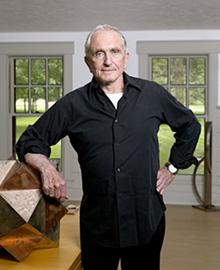Biography
Arthur Carter was born on December 24, 1931, in New York City. Trained as a classical pianist, he continued his studies in French literature at Brown University and received his AB in 1953. Mr. Carter served three years in the United States Coast Guard as a lieutenant (junior grade) and was honorably discharged in 1956. During that time he was commanding officer of a search air and rescue patrol craft. Thereafter, he went on to the Amos Tuck School at Dartmouth College and received his MBA in finance in 1959, all before embarking on a twenty-five-year-long career as an investment banker.
In 1981 he started his first newspaper, the Litchfield County Times, and six years later he founded the New York Observer. For Carter, the process of laying out and designing the overall look of two newspapers generated an interest in graphics. The front page of both newspapers relied on the square as its dominant theme. Carter began to convert the grids and geometries associated with the printed page from two dimensions to three, using stainless steel, a material that had been familiar to him since his days at Officer Candidate School, where he had learned the art of welding.
Arthur Carter’s career as a sculptor became the latest statement of his polymath proclivities. He was soon producing maquettes of wood, clay, and copper wire, which evolved into larger constructions in silicon bronze, copper and stainless steel—a number of which are on permanent public display in New York City, Washington, D.C., California and Connecticut. Carter maintains a production facility and design studio in Roxbury, Connecticut. Carter’s constructions may take months to complete, but they all begin with three simple tools: a sketch pad, a straightedge, and a compass.
The fabrication process for Carter’s sculptures is complex, involving all of the mechanicals of a modern-day machine shop. The surface finishes are varied and can be hand-polished, sanded, or burnished. Some sculptures are left with a metallic sheen, while others are painted. Many are activated by the changing conditions of light—shifting from brilliant mirrors to more subdued reflectors. The purposeful vibrations of light and shadow elevate each work, channeling life and motion into otherwise static, gridlike compositions.
“I like to keep the slate pure and clean,” Carter has said. “My work focuses on simplifying and eliminating the excessive. The question is how does purity of design lend itself to making a beautiful and elegant piece?” To answer this question, Carter turns to the foundation of mathematics, from Pythagoras to Fibonacci, whose twelfth-century discovery of the famous number series carries his name. Carter’s multidisciplinary approach to art making is not surprising, given the fact that prior to becoming a professional artist he had taken on many trades.
Arthur Carter, through his private equity holding company, Utilities & Industries Corp., has owned and operated more than one hundred industrial companies in the fields of printing; shipping; water utilities; shopping centers; real estate; cement, concrete, sand, and stone production; commercial banking; investment banking; retail distribution; meat packing; mining engineering; newspaper and magazine publishing; music publishing; television production; and the manufacturing of watches, precision springs, switches, mining equipment, electronics, and motor controls. Carter continues to own and operate a manufacturing company that makes precision springs, with factories in the United States, Mexico, United Kingdom, and China.
Carter believes his no-nonsense approach to finance extends to his art in many ways: “The simpler the economics are, the better; if you don’t understand it, you don’t do it. Purity in both design and business function means never dilute, never diffuse, and never bloat.”
Carter has held adjunct professorships in philosophy and journalism at New York University, where the Arthur L. Carter Journalism Institute was founded, and is currently a trustee of New York University and chairman of the Board of Overseers of the Faculty of Arts and Science at New York University.
Arthur Carter has been a featured solo artist at many galleries, including the Leila Heller Gallery in New York, Mattatuck Museum in Connecticut, Southampton Arts Center on Long Island, Tennessee State Museum in Nashville, the Grey Art Gallery and 80WSE Galleries at New York University in New York City, and the New Britain Museum of American Art in New Britain, Connecticut.
